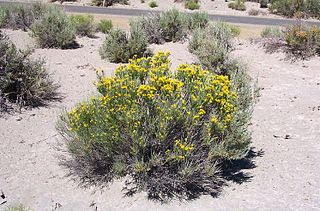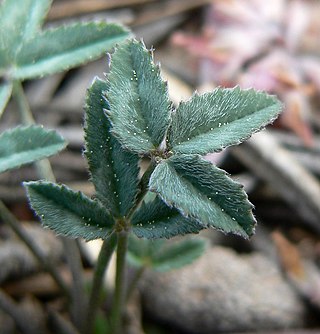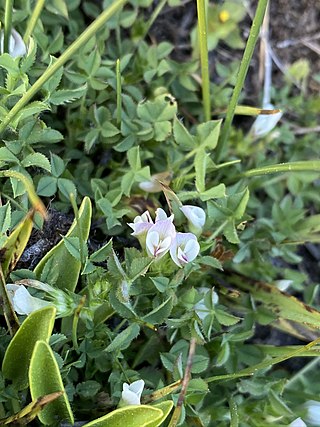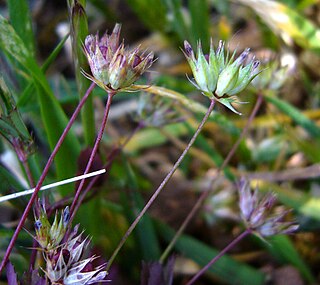
Ribes velutinum is a species of currant known by the common name desert gooseberry.

Stenotus lanuginosus is a species of flowering plant in the family Asteraceae known by the common names woolly mock goldenweed and woolly stenotus.

Tetradymia glabrata is a species of flowering plant in the aster family known by the common name littleleaf horsebrush. It is native to the western United States, especially the Great Basin and Mojave Desert. Its habitat includes sagebrush, woodlands, and scrub. It is an erect, bushy shrub growing to a maximum height over one meter, its stems coated unevenly in white woolly fibers with many bare strips. The narrow, pointed leaves are usually no more than a centimeter long and most occur in clusters along the branches. The inflorescence bears up to seven flower heads which are each enveloped in four woolly phyllaries. Each head contains four yellow cream flowers each around a centimeter long. The fruit is a hairy, ribbed achene with a pappus of bristles.

Tetradymia spinosa is a species of flowering plant in the aster family known by the common name shortspine horsebrush. It is native to the western United States, especially the basins and plateaus west of the Rocky Mountains. It grows in sagebrush, woodlands, and scrub habitat, often among shadscale in alkaline areas such as playas. It is a bushy shrub with many branches coated in woolly white fibers and growing to a maximum height around a meter. The leaves are narrow, curving, and hooklike, hardening into sharp spines up to 2.5 centimeters long. The inflorescence bears one or two flower heads which are each enveloped in four to six woolly phyllaries. Each head contains up to 8 tubular yellow disc flowers up to 1 cm long. The fruit is a densely hairy achene which may be nearly 2 cm long, including its pappus of long bristles.
Trifolium andersonii is a species of clover known by the common names fiveleaf clover and Anderson's clover. It is native to the western United States, particularly the Great Basin and adjacent high mountain ranges, including the Sierra Nevada. It was named after Charles Lewis Anderson by Asa Gray.
Trifolium beckwithii is a species of clover known by the common name Beckwith's clover.

Trifolium bifidum is a species of clover known by the common names notchleaf clover and pinole clover. It is native to the western United States from Washington to California, where it grows in many types of habitat. It is an annual herb spreading or growing erect in form. It is lightly hairy to hairless in texture. The leaves are made up of oval leaflets 1 to 2 centimeters long, usually with notches in the tips. The inflorescence is a head of flowers up to 1.5 centimeters wide. Each flower has a calyx of sepals that narrow to bristles covered in long hairs. The flower corolla is yellowish, pinkish, or purple and under a centimeter long. The flowers droop on the head as they age.
Trifolium buckwestiorum is a rare species of clover known by the common name Santa Cruz clover.

Trifolium depauperatum is a species of clover known by the common names cowbag clover, poverty clover, and balloon sack clover.

Trifolium eriocephalum is a species of clover known by the common name woollyhead clover or hairy head clover.

Trifolium fucatum is a species of clover known by the common names bull clover and sour clover. It is native to the western United States, where it grows in many types of habitat, becoming common to abundant in some areas. It is an edible species of clover.

Trifolium gymnocarpon is a species of clover known by the common name hollyleaf clover.
Trifolium lemmonii is a species of clover known by the common name Lemmon's clover.

Trifolium longipes is a species of clover known by the common name longstalk clover. It is native to the western United States, where it occurs in many types of habitats such as meadows, valleys, lower mountains, and subalpine slopes. There are many subtaxa which occur in different regions and differ slightly in appearance. In general, it is a perennial herb with leaves made up of 2 to 5 leaflets which are variable in shape. The inflorescence is a head of flowers up to 3 centimeters wide with white to purplish or bicolored corollas.

Trifolium microcephalum is a species of clover known by the common names smallhead clover and small-headed clover.

Trifolium microdon is a species of clover known by the common name thimble clover. It is native to western North America from British Columbia to southern California, where it grows in many types of habitat, including disturbed areas. It is an annual herb taking a decumbent or erect form. It is coated in hairs. The leaves are made up of oval leaflets with notched or flat tips, each measuring up to 1.5 centimeters long. The inflorescence is a head of flowers borne in a deep bowl-like involucre of bracts that can nearly envelop the whole head. The flower corollas are white to pink and about half a centimeter long.

Trifolium monanthum is a species of clover known by the common name mountain carpet clover.

Trifolium obtusiflorum is a species of clover known by the common name clammy clover. It is native to California in the Peninsular, Transverse, Sierra Nevada, and the California Coast Ranges and Cascade Range into southwestern Oregon.

Trifolium oliganthum is a species of clover known by the common name fewflower clover. It is native to western coastal and montane North America from British Columbia to California, the Sierra Nevada, and to Baja California, where it occurs in many types of habitat.

Cirsium perplexans is a species of flowering plant in the family Asteraceae known by the common names Rocky Mountain thistle and Adobe Hills thistle. It is endemic to Colorado in the United States, where it occurs in the Colorado and Gunnison River Valleys in the Rocky Mountains.


















